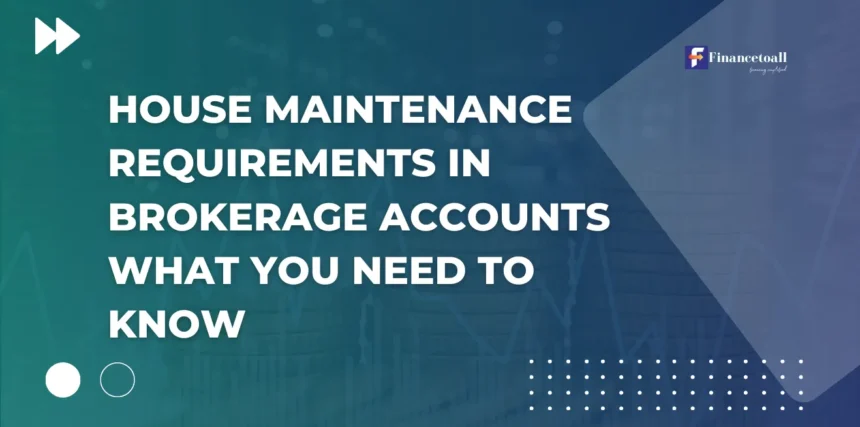When trading on margin, understanding house maintenance requirements is crucial to managing risk and avoiding unpleasant surprises like margin calls. These requirements, set by brokerage firms, ensure that traders maintain a minimum level of equity in their accounts, safeguarding both the trader and the brokerage from excessive risk. In this article, we’ll explore the key aspects of house maintenance requirements in the context of a brokerage account.
Key Takeways
What Are House Maintenance Requirements?
House maintenance requirements refer to the minimum equity that must be maintained in a margin account to avoid a margin call. Unlike the initial margin, which is governed by federal regulations like Regulation T, house maintenance requirements are specific to each brokerage firm. These firms may set stricter limits than those mandated by regulators to further protect themselves from potential losses.
Example to Understand House Maintenance Requirements
Let’s say you have a margin account with a brokerage that requires a 30% house maintenance requirement. You purchase $100,000 worth of stocks using a $50,000 margin loan, meaning you have $50,000 of your own equity in the account.
- Initial Equity: $50,000 (50% of the total $100,000 investment)
Now, assume the stock price drops, and the total value of your holdings decreases to $70,000. Your equity is now:
- New Equity: $70,000 – $50,000 (margin loan) = $20,000
At this point, you need to maintain 30% of the total market value ($70,000) as equity:
- Required Equity: $70,000 × 30% = $21,000
Since your current equity is only $20,000, which is below the required $21,000, your brokerage will issue a margin call. To satisfy the margin call, you would need to either:
- Deposit at least $1,000 into your account to bring the equity up to the required level.
- Sell some assets to reduce the margin loan and meet the requirement.
If you fail to take action, the brokerage may automatically sell some of your holdings to restore the account’s equity to the required level.
Difference Between House and Federal Maintenance Requirements
There are two primary types of maintenance requirements: federal and house.
- Federal maintenance requirements are set by FINRA and generally mandate that investors must maintain at least 25% of the total market value of the securities in their margin accounts.
- House maintenance requirements often exceed this federal minimum, with many firms requiring clients to maintain 30% to 40% of the value of their securities. Investors must ensure they meet both federal and house maintenance requirements to avoid penalties or asset liquidation.
Asset Types and Their Influence on Maintenance Requirements
Different assets come with varying risks, and brokerages adjust their maintenance requirements accordingly.
- Riskier assets like penny stocks or volatile options tend to have higher maintenance requirements, sometimes reaching 50% or more.
- A concentrated position in a single stock or sector can also result in higher requirements due to the increased risk of significant price fluctuations. It’s essential to understand how different assets impact your account’s maintenance margin to avoid unexpected margin calls.
Consequences of Not Meeting Maintenance Requirements
Failing to meet maintenance requirements can have serious consequences. If your equity falls below the required level, the brokerage will issue a margin call, requiring you to deposit more funds or liquidate some of your holdings to cover the shortfall.
If you do not respond to the margin call promptly, the brokerage may liquidate assets in your account without your consent to bring your account back into compliance. Understanding this risk is key to avoiding forced liquidation during market volatility.
How Maintenance Margin Is Calculated
Brokerages calculate your maintenance margin based on the market value of the securities in your account. For example, if your brokerage has a 30% house maintenance requirement, and you hold $100,000 worth of securities, you would need to maintain at least $30,000 in equity in your account.
Fortunately, many brokers provide real-time margin monitoring tools, allowing you to keep an eye on your equity levels and avoid unexpected margin calls.
Impact of Market Volatility
Market volatility can have a significant impact on your ability to meet maintenance requirements. During times of market stress, security prices can drop rapidly, increasing the likelihood of margin calls.
Brokerages may perform stress tests on accounts to ensure that clients can maintain the required level of equity during such fluctuations. Keeping a close watch on market conditions is critical when trading on margin, especially during times of high volatility.
Strategies to Avoid Margin Calls
There are several strategies you can use to avoid margin calls and protect your investments:
- Diversification: Spread your investments across a range of assets to reduce concentration risk.
- Monitoring Leverage: Be mindful of how much leverage you’re using and understand the risks that come with it.
- Maintain a Cushion: Keep more equity in your account than the minimum required. A buffer of extra funds can protect you from sudden market drops and prevent margin calls.
Flexibility of Brokerage Firms in Setting Maintenance Requirements
Brokerages often set their own house maintenance requirements based on the risk level of a client’s portfolio. These requirements may change dynamically, especially for highly volatile or illiquid assets.
Some firms may adjust maintenance requirements depending on your trading history or market conditions, so it’s important to stay informed and regularly review your brokerage’s policies.
Regulatory Oversight and Investor Protections
Federal regulations, like Regulation T and FINRA rules, set the baseline for margin trading and maintenance requirements, but brokerage firms are free to enforce stricter rules.
Brokerages are also required to inform clients about their maintenance margin requirements and any changes to these policies. Understanding these regulatory safeguards helps you manage your account effectively and avoid surprises.
Understanding Your Brokerage’s House Maintenance Policies
Before engaging in margin trading, thoroughly review your brokerage firm’s house maintenance policies. These can vary significantly between firms, and it’s important to know exactly what’s required to avoid unnecessary margin calls or forced liquidation.
Stay in regular communication with your broker, especially if you’re dealing with riskier assets or during times of market stress.
Historical Context: Lessons from Market Disruptions
There have been several notable instances of widespread margin calls during periods of extreme market volatility. For example, during the 2008 financial crisis and the COVID-19 pandemic, many investors faced margin calls as asset prices dropped rapidly.
These events serve as important reminders of the risks associated with margin trading. Investors should always maintain a conservative approach to leverage and ensure that they have sufficient liquidity to weather any market downturns.
Best Practices for Investors
To effectively manage a margin account, it’s essential to take several best practices into account:
- Evaluate your risk tolerance before using margin.
- Utilize risk management tools like stop-loss orders.
- Diversify your portfolio to minimize risk.
- Monitor your account regularly to ensure you remain in compliance with both house and federal maintenance requirements.
By following these guidelines, you can manage your margin account effectively and avoid the pitfalls of unexpected margin calls.
By understanding house maintenance requirements and how they work within your brokerage account, you can better manage your investments, protect your portfolio, and minimize risk. Whether you’re an experienced margin trader or just getting started, keeping these factors in mind will help you navigate the complexities of margin trading with confidence.
FAQ: House Maintenance Requirements in Brokerage Accounts
Q.1 What are house maintenance requirements?
House maintenance requirements are the minimum equity you must maintain in a margin account, as set by your brokerage firm. These rules ensure that the account has enough value to cover potential losses when trading on margin.
Q.2 How do house maintenance requirements differ from federal requirements?
While federal rules (set by FINRA) require at least 25% of the value of your securities in equity, brokerages often impose stricter house maintenance requirements, usually between 30% and 40%, to better manage risk.
Q.3 What happens if I don’t meet the house maintenance requirements?
If your account falls below the required maintenance level, the brokerage will issue a margin call. You must either deposit more funds or sell assets to meet the requirement. Failure to do so can result in the brokerage automatically liquidating your assets.
Q.4 Do different types of assets have different maintenance requirements?
Yes, riskier or more volatile assets like options, penny stocks, or leveraged ETFs often come with higher maintenance requirements compared to more stable securities like large-cap stocks.
Q.5 How can I avoid a margin call?
To avoid a margin call, keep a buffer of extra equity in your account, diversify your investments, and closely monitor your account, especially during volatile market conditions.
Q.6 Can my brokerage change the maintenance requirements?
Yes, brokerage firms have the authority to adjust house maintenance requirements at any time, based on market conditions or the specific securities in your account. It’s important to stay updated on any changes from your brokerage.








